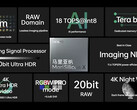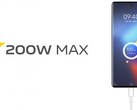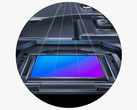Vivo has unveiled the X80 and X80 Pro as new phones enhanced by not merely Zeiss branding on their rear camera humps and all the collaboration that apparently goes on behind it, but by their very own ISP. Despite its name, the OEM has introduced the V1+ as a true second generation of its line of custom SoCs.
To that end, the processor is also an NPU, and is rated to take over some aspects of display response and battery conservation during gaming, thereby pushing it more into MariSilicon X territory. However, unlike its OPPO counterpart, it is compatible with the Dimensity 9000 found in the X80 and one X80 Pro variant as well as the Snapdragon 8 Gen 1 of the X80 Pro's other version.
Then again, Vivo has dedicated a whole press conference to its partnership with MediaTek to optimize the V1+ in the first two cases. This, apparently, should ensure that the 9000 achieves scores of well over 1 million in the AnTuTu benchmark, for example, through improvements in animation smoothness by about 50%. One might also have a better chance of running certain games at either 90 or 120 fps thanks to the V1+.
Vivo refers to its new ISP as a "dual-core" chipset (like its forebear), although it has yet to outline their make-up or specs in any detail. Then again, the company has revealed that they support 32MB of static RAM (SRAM) and a maximal throughput of 8 gigabytes per second (GB/s).
These specs may drive a drop in power consumption by up to 72%, for an energy efficiency boost of up to 300%, compared to the first-gen V1. Its successor is also tipped to one-up it as an actual ISP as well, of course.
This process involves headlines such as its application to XDR Photo, a Vivo-developed dynamic-range tweak touted to increase brightness in images by up to 350% when the V1+ deems it appropriate to do so.
There is also an AI Perception Engine, which has apparently been trained on experiential data gleaned from "professional photographers" in order to inform the use of light on the X80 or X80 Pro.
That feature might boost auto-white balance accuracy by up to 12%, and "brightness accuracy" by up to 16%, compared to "traditional" measurements of the same. Then again, there is also a Zeiss "natural color" mode that should reproduce what the user actually sees in images in some situations on the X80 series.
Then again, the V1+'s AI-imparted learning is imposed on the Zeiss tuning to some degree: for example, it is rated to boost the classic brand's default color ΔE tweaks "by ~8.3%". The ISP is also backed by its maker to confer "3D real-time stereo" noise-reduction in low light and smart frame insertion thanks to MEMC. In fact, Vivo is confident that an X80-series unit can take photos in ambient light conditions equivalent to 1 lux or less.
All in all, the V1+ has been hyped as a way to boost high-intensity tasks such as gaming as well as camera functions exclusive to the new X80 and X80 Pro, particularly ones that ship with the new Dimensity 9000 processor from MediaTek. Therefore, it may be all the more of a shame that their Qualcomm counterpart is the one most likely to make it into international markets.

































